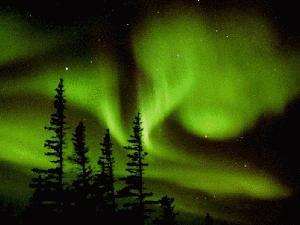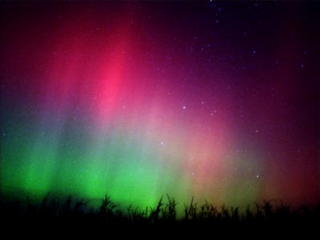
Going to the northerly university of Eau Claire, Wisconsin afforded me three things.
1. More bars per capita then any other city in the United States at that time.
2. A bridge all off-campus students had to cross that, during the winter, was one of the coldest spots outside of Fargo.
3. An occasional glimpse of the aurora borealis.
The first time I saw it, a friend was leaving the apartment late one night when he rushed back in with more excitement than I'd even seen him exhibit sans alcohol and told us (my room mates and I) that we had to come outside. Once there, we looked up and the entire night sky was covered with an undulating emerald green. We stood for 45 minutes until it passed, all of us silent and smiling. It was incredibly beautiful.
From a purely astronomical standpoint, an aurora is an optical phenomenon characterized by colorful displays of light in the night sky, caused by the interaction of charged particles from the solar wind with the upper atmosphere of a planet. The most powerful aurorae tend to occur after coronal mass ejections. Sightings on the earth's Northern Hemisphere are called the aurora borealis where sightings on the Southern Hemisphere the aurora australis. For a full on treatise of this phenomena, look to Wikipedia.
There are even sounds that have been associated with the aurora that are said to sound like a hum or song. Auditory experiences commonly occur only when the observer is well removed from noise and light pollution and when the night in questions is cold and windless.
The Spaceweather site from Nasa has a great collection of photographs. Solar Soft has a predictor that lets the avid astronomer know when auroras are most likely to occur.
Photographing them is an art in and of itself. There is a great page of how to's here.
Most sightings are of the emerald green variety. But rainbow colors have been observed by those luckier than me. I still felt blessed.
Ancient Scandinavians thought the aurora was the sky reflecting schools of herring (herring flash), the Finnish called them fire foxes after the legend of a fox made of fire and the Inuit thought it was comprised of the spirits of the dead playing football with a walrus skull over the sky. The most ancient legends in Europe considered it to be a peek at purgatory.
Physics or magic, it is a profound experience to see these lights work their way across a star strewn night sky.

2 comments:
I like the idea of spirits playing football with a walrus skull...
I've seen them twice... astonishingly beautiful and so very humbling.
Post a Comment